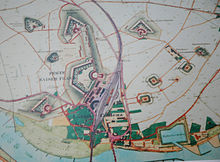Neuendorfer Flesche


The Neuendorfer Flesche was part of the Prussian fortress Koblenz and belonged to the Feste Kaiser Franz system . From the Flesche , which was completed in 1825 in what is now the Koblenz district of Lützel , only subterranean remains in the area of the Rhine barracks have been preserved after it was razed in 1910 . It is named after the neighboring district of Neuendorf .
history
The Neuendorfer Flesche was built between 1821 and 1825 as part of the fortress system Feste Kaiser Franz under the direction of the Prussian engineer captain Franz Xaver Cornely, presumably according to plans by Colonel Gotthilf Benjamin Keibel . The basic pattern of the Flesche (French: flèche = arrow) has been preserved from the plan of the espionage report drawn up by Lieutenant John Humly Humfrey. After the Flesche was completed, two Rhenish infantry regiments immediately occupied the facility.
With the other works of the Feste Kaiser Franz system, the Flesche was finally closed in 1890. The fortress was razed in 1910. All parts of the fortress above ground were demolished and the demolition in the main trench of the complex was filled. The underground parts have been almost completely preserved to this day. In the following years, the Coblenz-Lützel Train Barracks was built on the site of the fortress . During the Second World War , the people of Lützel and Neuendorf sought protection from air raids in the underground passages . Parts of the equipment have been preserved. The Rhine barracks now stand on the site of the former fortress .
At the end of the 1980s, the existing underground parts were excavated and partially removed. In 1987 the remains of the Flesche were first explored and documented. The Förderverein Neuendorfer Flesche e.V. was founded in 1990 to preserve the remains, which still fully show the shape and dimensions of the Flesche in the ground . V. Contreescarpen galleries of the face and throat as well as several three-part gun capons and listening passages in the glacis have been preserved to this day . The ditch and part of the escarpe with the adjoining Dechargen casemates were painstakingly reconstructed in 1995 in the middle of the right face.
construction
The front of the Neuendorfer Flesche was directed to the north and consisted of two almost equally long faces . The left line was broken and an almost lunette-like floor plan was created. The line on the right connected to the reduit in an offset manner . Behind the ramparts was an elliptical reduit with an attached caponiere ( orillon ), which closed the work at the back. There was communication between the individual parts of the work . Bridges and ramps secured access to the Wallhof and the Reduit. The reduit was used to set up mortars or cannons and to accommodate the soldiers. Under the main wall was a large casemate corps with the escarpe.
Below the outer fortress system was the Kontreeskarpe with the mine gallery (each 100 meters long) and the listening tunnels (about 10 meters long). The dry main ditch, 6 meters deep and 17 meters wide, was created between the Kontreeskarpe and the Escarpe.
Monument protection
The Neuendorfer Flesche has been a protected cultural monument under the Monument Protection Act (DSchG) since 1988 and is entered in the list of monuments of the state of Rhineland-Palatinate . It is located in Koblenz-Lützel on the grounds of the Rhine barracks at (near) Andernacher Straße 100 .
The Neuendorfer Flesche has been part of the UNESCO World Heritage Upper Middle Rhine Valley since 2002 .
See also
literature
- Thomas Tippach (Diss.): Koblenz as a Prussian garrison and fortress city economy, infrastructure and urban development . 2000 (series: urban research, series A: representations volume 53), ISBN 3-412-08600-2
- Klaus T. Weber (dissertation): The Prussian fortifications of Koblenz (1815–1834) . (Series: Art and Cultural Studies Research) 2003, ISBN 3-89739-340-9
- Rüdiger Wischemann: The Koblenz Fortress. From the Roman fort and Prussia's strongest fortress to the largest garrison of the German Armed Forces , Koblenz 1978 (note: outdated in many ways, but still the best representation for an overview)
- Wolfgang Klefisch: The Neuendorfer Flesche - from the fortress model to the New Prussian fortress. 1990, 3rd edition 2006, Bornheim (Rhl)
- Ulrike Weber (edit.): Cultural monuments in Rhineland-Palatinate. Monument topography Federal Republic of Germany. Volume 3.3: City of Koblenz. Districts. Werner, Worms 2013, ISBN 978-3-88462-345-9 .
Web links
- Website of the Friends of Neuendorfer Flesche e. V.
- Website of the Friends of Feste Kaiser Franz e. V.
Individual evidence
- ↑ General Directorate for Cultural Heritage Rhineland-Palatinate (ed.): Informational directory of cultural monuments - district-free city of Koblenz (PDF; 1.5 MB), Koblenz 2013
Coordinates: 50 ° 22 ′ 28.7 " N , 7 ° 35 ′ 50.8" E


